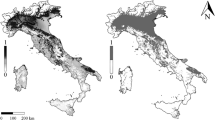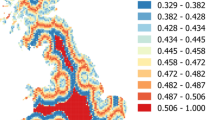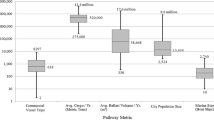Abstract
Invasive zebra mussels (Dreissena polymorpha) pose both a significant economic and environmental threat to aquatic systems yet there are currently no effective methods for achieving large-scale eradication. As a result, predicting and preventing their spread play a critical role in management efforts. Zebra mussels were first found in Texas in 2009 and, as of November 2019, have invaded 39 lakes across five river basins. Prior state-specific risk-assessments have been solely based on habitat suitability and have not considered dispersal potential. We developed a water body specific, constrained gravity model incorporating habitat suitability and dispersal potential to predict potential future invasion patterns. We examined the relative importance of habitat suitability, lake attractiveness, the relative risk of different boater types, and the impact of boater compliance with recommended prevention measures. Differences in lake attractiveness resulted in different boater dispersal patterns but the impact on projected lake invasions were reduced by variation in habitat suitability. The model projected zebra mussels to be mainly limited by habitat conditions in east Texas and by dispersal in west Texas. Most lakes in central Texas were projected to become invaded in the near future unless boater compliance with preventive management was high.








Similar content being viewed by others
References
Adams DC, Lee DJ (2012) Technology adoption and mitigation of invasive species damage and risk: application to zebra mussels. J Bioecon 14:21–40
Bartell SM, Wu Y, Nair SK, Orr J, Ragland J (2007) Risk assessment and decision analysis support for invasive mussel management for the St. Croix Basin and Adjacent Upper Mississippi River. Contract (W912ES-05)
Benson AJ, Raikow D, Larson J, Fusaro A, Bogdanoff AK, Elgin A (2019) Dreissena polymorpha (Pallas, 1771): U.S. Geological Survey, Nonindigenous Aquatic Species Database, Gainesville, FL. https://nas.er.usgs.gov/queries/FactSheet.aspx?speciesID=5. Accessed 16 April 2019
Bossenbroek JM, Kraft CE, Nekola JC (2001) Prediction of long-distance dispersal using gravity models: zebra mussel invasion of inland lakes. Ecol Appl 11:1778–1788
Bossenbroek JM, Johnson LE, Peters B, Lodge DM (2006) Forecasting the expansion of zebra mussels in the United States. Conserv Biol 21:800–810
Carlton JT (2008) The zebra mussel Dreissena polymorpha found in North America in 1986 and 1987. J Great Lakes Res 34:770–773
Chivers C, Drake AR, Leund B (2017) Economic effects and the efficacy of intervention: exploring unintended effects of management and policy on the spread of non-indigenous species. Biol Invasions 19:1795–1810
Cole E, Keller RP, Garbach K (2019) Risk of invasive species spread by recreational boaters remains high despite widespread adoption of conservation behaviors. J Environ Manag 229:112–119
De Ventura L, Weissert N, Tobias R, Kopp K, Jokela J (2016) Overland transport of recreational boats as a spreading vector of zebra mussel, Dreissena polymorpha. Biol Invasions 18:1451–1466
Drake JM, Bossenbroek JM (2004) The potential distribution of zebra mussels in the United States. Bioscience 54:931–941
Gallien L, Münkemüller T, Albert CH, Boulangeat I, Thuiller W (2010) Predicting potential distributions of invasive species: where to go from here? Divers Distrib 16:331–342
Gelbard JL, Belnap J (2003) Roads as conduits for exotic plant invasions in a semiarid landscape. Conserv Biol 17:420–432
Grimm V, Berger U (2003) Seeing the forest for the trees, and vice versa: pattern-oriented ecological modelling. In: Seuront L, Strutton P (eds) Handbook of scaling methods in aquatic ecology: measurement, analysis, simulation. CRC Press, Boca Raton, pp 411–428
Grimm V, Revilla E, Berger U, Jeltsch F, Mooij WM, Railsback SF, Thulke HH, Weiner J, Wiegand T, DeAngelis DL (2005) Pattern-oriented modeling of agent-based complex systems: lessons from ecology. Science 310:987–991
Gunn JM, Sein R (2000) Effects of forestry roads on reproductive habitat and exploitation of lake trout (Salvelinus namaycush) in three experimental lakes. Can J Fish Aquat Sci 57:97–104
Higgins SN, Vander Zanden MJ (2010) What a difference a species makes: a meta-analysis of dreissenid mussel impacts on freshwater ecosystems. Ecol Monogr 80:179–196
Hincks SS, Mackie GL (1997) Effects of pH, calcium, alkalinity, hardness, and chlorophyll on the survival, growth, and reproductive success of zebra mussel (Dreissena polymorpha) in Ontario Lakes. Can J Fish Aquat Sci 54:2049–2057
Hodkinson DJ, Thompson K (1997) Plant dispersal: the role of man. J Appl Ecol 34:1484–1496
Hulme PE (2009) Trade, transport and trouble: managing invasive species pathways in an era of globalization. J Appl Ecol 46:10–18
Jacobs MJ, MacIsaac HJ (2009) Modelling spread of the invasive macrophyte Cabomba caroliniana. Freshw Biol 54:296–305
Janssen MA, Radtke NP, Lee A (2009) Pattern-oriented modeling of commons dilemma experiments. Adaptive Behavior 17:508–523
Johnson LE, Carlton JT (1996) Post-establishment spread in large-scale invasions: dispersal mechanisms of the zebra mussel Dreissena polymorpha. Ecology 77:1686–1690
Johnson PD, McMahon RF (1998) Effects of temperature and chronic hypoxia on survivorship of the zebra mussel (Dreissena polymorpha) and Asian clam (Corbicula fluminea). Can J Fish Aquat Sci 55:1564–1572
Johnson LE, Ricciardi A, Carlton JT (2001) Overland dispersal of aquatic invasive species: a risk assessment of transient recreational boating. Ecol Appl 11:1789–1799
Jongejans E, Skarpaas O, Ferrari MJ, Long ES, Dauer JT, Schwarz CM, Rauschert ESJ, Jabbour R, Mortensen DA, Isard SA (2015) A unifying gravity framework for dispersal. Theor Ecol 8:207–223
Leung B, Lodge DM, Finnoff D, Shogren JF, Lewis MA, Lamberti G (2002) An ounce of prevention or a pound of cure: bioeconomic risk analysis of invasive species. Proc R Soc Lond B 269:2407–2413
Leung B, Bossenbroek JM, Lodge DM (2007) Boats, pathways, and aquatic biological invasions: estimating dispersal potential with gravity models. Biol Invasions 8:241–254
Lodge DM, Simonin PW, Burgiel SW, Keller RP, Bossenbroek JM, Jerde CL, Kramer AM, Rutherford ES, Barnes MA, Wittmann ME, Chadderton WL, Apriesnig JL, Beletsky D, Cooke RM, Drake JM, Egan SP, Finnoff DC, Gantz CA, Grey EK, Hoff MH, Howeth JG, Jensen RA, Larson ER, Mandrak NE, Mason DM, Martinez FA, Newcomb TJ, Rothlisberger JD, Tucker AJ, Warziniack TW, Zhang H (2016) Risk analysis and bioeconomics of invasive species to inform policy and management. Annu Rev Environ Resour 41:453–488
McMahon RF (2015) Implementation of a cost-effective monitoring and early detection program for zebra mussel invasion of Texas water bodies. In: Wong WH, Gerstenberger SL (eds) Biology and management of invasive quagga and zebra mussels in the Western United States. CRC Press, Taylor Francis Group, Boca Raton, pp 349–374
Morandi MJ, Manning NF, Bossenbroek JM, Jerde CL (2015) Assessing the influence of different inland lake management strategies on human-mediated invasive species spread. Manag Biol Invasions 6:57–69
National Marin Manufacturers Association (2010) U.S. Recreational Boat Registration Statistics Report. https://www.nmma.org/press/article/18028. Accessed December 2017
Niggemann M, Jetzkowitz J, Brunzel S, Wichmann MC, Bialozyt R (2009) Distribution patterns of plants explained by human movement behavior. Ecol Model 220:1339–1346
Peterson AT, Vieglais DA (2001) Predicting species invasions using ecological Niche modeling: new approaches from bioinformatics attack a pressing problem: a new approach to ecological niche modeling, based on new tools drawn from biodiversity informatics, is applied to the challenge of predicting potential species’ invasions. Bioscience 51:363–371
Pimentel D, Zuniga R, Morrison D (2005) Update on the environmental and economic costs associated with alien-invasive species in the United States. Ecol Econ 52:273–288
Potapov A, Muirhead JR, Lele SR, Lewis MA (2011) Stochastic gravity models for modeling lake invasions. Ecol Model 222:964–972
Ramcharan CW, Padilla DK, Dodson SI (1992) Models to predict potential occurrence and density of the zebra mussel, Dreissena polymorpha. Can J Fish Aquat Sci 49:2611–2620
Reed-Anderson T, Bennett EM, Jorgensen BS, Lauster G, Lewis DB, Nowacek D, Riera JL, Sanderson BL, Stedman R (2000) Distribution of recreational boating across lakes: do landscape variables affect recreational use? J Freshw Biol 43:439–448
Ricciardi A, Serrouya R, Whoriskey FG (1994) Aerial exposure tolerance of the zebra and quagga mussel (Bivalvia: Dreissenidae): implications for overland dispersal. Can J Fish Aquat Sci 52:470–477
Rothlisberger JD, Lodge DM (2010) Limitations of gravity models in predicting the spread of Eurasian Watermilfoil. Conserv Biol 25:64–72
Schneider DW, Ellis CD, Cummings KS (1998) A transportation model assessment of the risk to native mussel communities from zebra mussel spread. Conserv Biol 12:788–800
Stewart-Koster B, Olden JD, Johnson PT (2015) Integrating landscape connectivity and habitat suitability to guide offensive and defensive invasive species management. J Appl Ecol 52:366–378
Strayer DL (1991) Projected distribution of the zebra mussel, Dreissena polymorpha, in North America. Can J Fish Aquatic Sci 48:1389–1395
Strayer DL (2009) Twenty years of zebra mussels: lessons from the mollusk that made headlines. Front Ecol Environ 7:135–141
Tamayo M, Olden JD (2014) Forecasting the vulnerability of lakes to aquatic plant invasions. Invasive Plant Sci Manag 7:32–45
Texas Boat Registration (2016) Texas Open Data Portal. https://data.texas.gov/Recreation/Texas-Boat-Owners/7rtb-7kuz. Accessed on 10 Feb 2017
Texas Commission on Environmental Quality (2007) Acid rain potential in east Texas reservoirs. https://www.tceq.texas.gov/assets/public/comm_exec/pubs/as/198.pdf. Accessed 10 Jan 2017
Texas Commission on Environmental Quality (2014) TCEQ Segments-GIS Data. https://www.tceq.texas.gov/gis/download-tceq-gis-data. Accessed 6 Oct 2017
Texas Commission on Environmental Quality (2017). Water Quality Data and Surface Water Quality Monitoring Information System’s Web Reporting Tool. Accessed December 2017. https://www80.tceq.texas.gov/SwqmisPublic/public/default.htm
Texas Department of State and Health Services (2014) Texas Population, 2016 Projection. https://www.dshs.texas.gov/chs/popdat/ST2016p.shtm. Accessed on 10 Feb 2017
Texas Parks and Wildlife Department (2019) “The Zebra Mussel Threat”. https://tpwd.texas.gov/huntwild/wild/species/exotic/zebramusselmap.phtml. Accessed May 2019
Texas Water Development Board (2016). Texas Lakes and Reservoirs. http://www.twdb.texas.gov/surfacewater/rivers/reservoirs/index.asp. Accessed 6 Dec 2016
Thomas RW, Hugget RJ (1980) Modeling in geography. Barnes & Noble Books, Totowa
Timar L, Phaneuf DJ (2009) Modeling the human-induced spread of an aquatic invasive: the case of the zebra mussel. Ecol Econ 68:3060–3071
Wang M, White N, Grimm V, Hofman H, Doley D, Thorp G, Cribb B, Wherritt E, Han L, Wilkie J, Hanan J (2018) Pattern-oriented modelling as a novel way to verify and validate functional-structural plant models: a demonstration with the annual growth module of avocado. Ann Bot 121:941–959
Whittier TR, Ringold PL, Herlihy AT, Pierson S (2008) A calcium-based invasion risk assessment of zebra and quagga mussels (Dreissena spp.). Front Ecol Environ 6:180–184
Wiegand T, Jeltsch F, Hanski I, Grimm V (2003) Using pattern-oriented modeling for revealing hidden information: a key for reconciling ecological theory and application. Oikos 100:209–222
Wilensky U. (1999) NetLogo. http://ccl.northwestern.edu/netlogo/. Center for Connected Learning and Computer-Based Modeling, Northwestern University, Evanston
Wilson JRU, Dormontt EE, Prentis PJ, Lowe AJ, Richardson DM (2008) Something in the way you move: dispersal pathways affect invasion success. Trends Ecol Evol 24:136–144
Wittmann ME, Kendall BE, Jerde CL, Anderson LWJ (2015) Estimating relative risk of within-lake aquatic plant invasion using combined measures of recreational boater movement and habitat suitability. PeerJ 3:e845. https://doi.org/10.7717/peerj.845
Wu Y, Bartell SM, Orr J, Ragland J, Anderson D (2010) A risk-based decision model and risk assessment of invasive mussels. Ecol Complex 7:243–255
Acknowledgements
We would like to thank Texas Parks and Wildlife Department, Texas Commission on Environmental Quality, and Texas Water Development Board for providing data used in the development of this model. This research was supported by Texas Parks and Wildlife Department Statewide Aquatic Vegetation and Invasive Species Management funding.
Author information
Authors and Affiliations
Corresponding author
Additional information
Publisher's Note
Springer Nature remains neutral with regard to jurisdictional claims in published maps and institutional affiliations.
Appendix
Appendix
Rights and permissions
About this article
Cite this article
Robertson, J.J., Swannack, T.M., McGarrity, M. et al. Zebra mussel invasion of Texas lakes: estimating dispersal potential via boats. Biol Invasions 22, 3425–3455 (2020). https://doi.org/10.1007/s10530-020-02333-2
Received:
Accepted:
Published:
Issue Date:
DOI: https://doi.org/10.1007/s10530-020-02333-2




